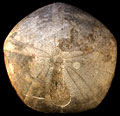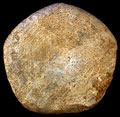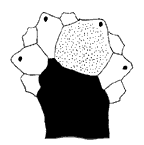The Echinoid Directory
Pygaster L. Agassiz, 1836, p. 185
[=Plesiechinus Pomel, 1883, type species Pygaster macrostoma Wright, 1861; =Megapygus Hawkins, 1912, type species Pygaster umbrella Agassiz, 1839 [=Pygaster semisulcatus (Phillips, 1829)], objective; =Macropygus Pomel, 1883, p. 70, type species Pygaster truncatus Agassiz, 1840. ]
| Diagnostic Features |
|
|---|---|
| Distribution | Middle Jurassic (Bajocian) to Late Cretaceous (Cenomanian) of Europe. |
| Name gender | masculine |
| Type | Clypeus semisulcatus Phillips, 1829 by subsequent designation of Savin, 1905, p. 187. |
| Species Included |
|
| Classification and/or Status |
|
| Remarks |
|




